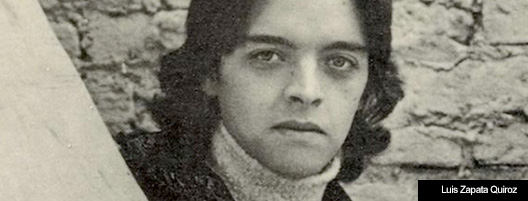(MIS)COMMUNICATION IN LUIS ZAPATA’S ¿POR QUÉ NO NOS VAMOS?
Por Mark Bates*
When the prominent Russian Formalist Roman Jakobson offered his concluding remarks at the Conference on Style held at Indiana University in 1958, it can assumed that the now famous model of verbal communication, addresser, context, message, contact, code, and addressee that he presented in the following model:
context
message
addresser————–addressee
contact
code
Robert Scholes explained clearly and concisely what Jakobson meant, “Jakobson’s communication theory provides us with a handy way of analyzing the six elements in any speech event. Whether we are considering ordinary conversation, a public speech, a letter, or a poem, we always find a message which proceeds from a sender to a receiver. These are the most obvous aspects of communication. But a successful communication depends on three other aspects of the event as well: the message must be delivered through a contact, physical and/or psychological; it must be framed in a code, and it must refer to a context.”¹) was designed to analyze communication acts that intended to communicate; that is that there existed an addresser and addressee that within any given speech act actually desired to send and receive a message. Armed with that assumption, critics have explained and reinterpreted the model, as demonstrated in Robert Scholes’ article “From Linguistics to Poetics” in Structuralism in Literature. Scholes altered the translation of Jakobson’s terminology (addresser to sender and addressee to receiver) and expanded Jakobson’s original application when he stated, “The message itself, uniting sender and receiver in the quintessentially human act of communication, is simply a verbal form, which depends on all other elements of a speech event to convey its meaning. The message is not meaning. Meaning lies at the end of the entire speech event, which gives the verbal formula of the message its life and color.”² This reinterpretation of Jakobson’s communication act model created the intellectual space for the emergence of the speech – act theorists such as Mary Louise Pratt, as well as numerous applications of Jakobson’s theory to literary texts. John S. Brushwood’s article “Message and Meaning: Federico Gamboa’s Suprema Ley” in his Genteel Barbarism: New Readings of Nineteenth-Century Spanish-American Novels remains an excellent example of this process. Brushwood intended to apply 20th century critical models to previously studied texts to reveal textual omissions from more traditional criticism. Through his textual analysis, Brushwood discovers that as he considers the novel as one speech act, the implied author of Suprema Ley seeks to persuade the reader that “the established social institutions of his culture are good and that they exercise a potentially redemptive function”.³ As he applies the theory to individual speech acts he determines that individual characters of Suprema Ley assume roles in the undertaking outlined above. Through an application of Jakobson’s theory and other concepts taken from Gérard Genette and Wayne Booth,4 Brushwood identified features of the novels previously undetected by the novel’s critics.

As stated earlier, implicit in this process of the application of Jakobson’s theory to texts is the assumption that a sender does wish to communicate a message to a receiver. For the purpose of this study, let us consider a text where the communication act becomes a miscommunication act; where the author or implied author wishes to undermine the communication process; making an identifiable exchange of ideas impossible. Such is the case with Mexican author Luis Zapata’s 1992 novel Por qué mejor no nos vamos?, which has received a somewhat negative critical reception. On the surface, the novel seems to lack an identifiable plot; two gay men whom we can only identify as the driver and the Valium taking passenger, whom the reader may or may not assume to be lovers, take a vacation via automobile from Mexico City to Veracruz during which they discuss the success and failure of their rather sordid amorous adventures of the past as they bicker, argue, complain, and generally verbally assault one another. The chaotic structure of the novel would appear to create a major flaw, a mixture of dialogue between the two men and erotic recollections of the past. The reader joins the novel’s opening and subsequent conversation midstream, unaware of the importance or lack thereof of pervious dialogue. Often the reader is unsure which of the two men is talking at any given point, since the novel lacks adequate character development. The novel ends with an “open ending: in which the two men continue their journey after a verbal exchange nearly becomes a physical altercation. Finally, one of the two suggests that they continue the trip.
The apparent problems created by a first reading emphasizing plot and character development dissolve with the application of Jakobson’s communication model to the text. ¿Por qué mejor no nos vamos? Fails to develop strong characters, demonstrates no central theme, and reveals a weak plot line precisely because its conflicts do not revolve around characters, themes and plots. This study will explore each of the six communication elements Jakobson delineated showing how the novel disintegrates the communication process into miscommunication by obfuscating or altering the importance of each element. The results leave the reader with a linguistic model of miscommunication that, considered as a single speech-act, imply a direct criticism of homosexual culture in Mexico.

The Sender: Missing in Action
The first element in Jakobson’s model, the sender, the basic block in the communication act, denotes in literary terms a narrator who, at some level represents of reflects the intentions of the author, or as Brushwood has stated, “The sender should be understood as three different but related entities, suggested by Wayne Booth: 1) the author (2) the implied author, and (3) the narrator.”5 The author and implied author of ¿Por qué mejor no nos vamos? are connected to the homosexual community in Mexico and are familiar with the latest gay slang. The structural breakdown occurs in the relationship between the authors and the narrator. The third person omniscient narrator lacks a presence; never enters into the action of the novel, never comments on the events, never reacts to the dialogue. The narrator simply supplies the reader with the dialogue between the two characters, either in fragments or its entirety, neither of which the reader can determine. The narrator becomes absent from the text, presenting dialogue as if accompanying the pair, but never revealing to the reader the important facts of the conversation: who is talking how did the conversation begin or end, or how does it relate to the relationship between the two characters. When we consider individual speech acts, the dialogues between the two lovers, the same difficulty exists. The reader remains unsure of which of the two is talking, making it impossible at this level to determine the substance of a conversation.
The Receiver: Nobody’s Home
When individual dialogues throughout the novel are examined, a curious pattern develops. The receiver (the responding character) tends to ignore the sender’s message through a series of unconventional techniques: in one instance the receiver falls asleep, “¿no te has fijado que hay ciertas pesencias que como tedejan su huella en tu cuerpo? ¿A poco no?..¿Qué y a te dormiste?”6 , at other times the receiver distorts the communication through linguistic play and double entendre,
-“Te perdono porque perteneces a una especie en extinción: la de los mataputos.
-¿En extinción? Cómo se ve que no has estado en San Luis Potosí.
-¿San Luis Jotosí o San Luis Potosí?
-¡Ay que reconfortante! Tú también manejas el humor popular: ya me estaba emezando a sentir sola.” (Zapata, p. 13),
or by refusing to answer,
-Pues, lo dirás de chiste, pero a mí se me hace muy autodestructivo, muy pinche: es el primer paso hacia la mediocridad, hacia la indolencia total.
-¿Tan grave así?
-….
-….” (Zapata, p. 44),
or by changing the subject,
“-Es como un divorcio, como una enemistad entre el cuertpo y la mente: cuando más jodido estás, más te chinga.
-¿De qué estás hablando?
-¿Cómo de qué estoy hablando? ¡Pues del insomnio, cabron! Estás en la luna.” (Zapata, p. 44).
These communication gaps obfuscate the message consistently through the text. Often the two characters revert to name calling and other verbal abuses. Repeatedly the receiver refuses to participate in the communication act.

The Message: Who’s on first?
Since the message becomes distorted between a sender who often fails to send it clearly and a receiver who is at best disinterested in receiving it, the reader struggles to determine the message’s content or intent. While there seems to exist a connecting narrative line concerning the struggles of homosexuals in a homophobic society and the frequent failure of representative amorous encounters, the message the two characters want to relay to each other become garbled by other factors of interference; the constant joking, the intentional miscommunications, the sidetracking behaviors demonstrated by both characters, and the frequent verbal confrontations. When considered as one speech act, ¿Por qué mejor no nos vamos? possibly carries as its message the nature of Mexican gay culture to the text-act reader. But this process is inconsistent; often the conversations become intertwined with literary and intellectual debates mixed with satire which further confuse the issue,
-“…de repente me sentí como en una película del Indio Fernández. O un cuento de Juan Rulfo, ¡qué horror!
-¿Rulfo es ese señor que escribía argumentos para comedias rancheras?
-El mismo
-¿No se te hace que vas muy rápido?
-No mames, no seas maricón.
-Lo sorprendente de tu vocabulario es que no evoluciona en absolute: segues hablando como hablaba la clase media alemanista” (Zapata, p. 27).
Context: Out of bounds
Through a seeming endless stream of random, disconnected or rambling referents, the context of the message has disintegrated. While the reader might suspect that the novel’s context might be Mexican homosexuality in the 1990’s, so many other topics of discussion enter into the novel’s development that homosexuality often becomes a secondary theme. The two characters constantly text each other on the subjects of linguistics, art, philosophy, popular culture, gay literature, history, archeology, and science. The subjects of conversations move wildly from topic to topic through a series of loose associations, semiotic distortions, or direct parodies. A discussion on philosophy quickly dissolves into popular culture as evidenced by this passage:
“-¿O no sera una cuestión de poder, tú?
-¡Ajá!, veo que también has estado releyendo a Adler, pillina.
-No, fíjate, más bien a Lowen…ahí sí no puedes dominar; y como ya se sabe que a ti todo lo que implique lucha ted a miedo…
-Excepto Lucha Reyes, que más bien me da lástima: sufrió tato la pobre.
-Qué mal chiste; digo ya es tan gastado: nomás te faltó decir Lucha Villa.
-O tu tía Lucha.
-Como todo lo que implique lucha ted a…
-O lucha libre.” (Zapata, p. 62)

Contact and Code: The Language of Love
Contact and code are the two linguistic elements in Jakobson’s model; in testual applications of his communication theory these two elements take on minor roles in the determination of meaning in the text. In ¿Por qué mejor no nos vamos? they become central to that paradigm since the other elements of communication have been successfully confused, twisted or destroyed. The contact of the novel lies in the series of disjointed dialogues themselves without beginning or end, and the code is language itself: a synthesized gay speak which is indecipherable to the outsider but seems to carry meaning for the two interlocutors. The implied author alluded to this linguistic code earlier in the novel when one character tells the other: “Eso déjalo para cuando escribas un ensayo sobre la semiótica de la jotería” (Zapata, p. 10). Zapata has successfully created a manifesto of gay language and gay manner; the art of communicating using this code system lies in the sum of its miscommunications. While miscommunicating the two characters communicate but at a level distinct from the connotation of the words they are using. Our two characters express a deep affection and love for one another: unable to use the code of heterosexuality, they employ “la semiótica de la jotería”: a series of satires, double entendre, word plays, verbal abuses, and linguistic transformations. Despite their miscommunications, their desire to communicate to one another remains clear; at the end of the novel the reader encounters this surprising exchange,
“-Pero ya vamónos, pues. ¡Muévete! Ahí en el coche sequimos platicando. Tengo muchas reflexiones interesantísimas y novedísimas que comunicarte. Estuve pensando…
-Qué padre: por nada del mundo me gustaría perdémelas. Vámonos, pues.” (Zapata, p. 131).
The Message and Meaning: (Mis)communicating
Returning to Jakobson’s model, the reader identifies the component parts of ¿Por qué mejor no nos vamos? a novel that communicates by miscommunicating. The model of miscommunication can be represented thusly:
Context: Mexican Gay Culture
Message: Inability to express love through ordinary linguistic
channels due to inherent flaws in gay language
Sender————————————-Receiver
(Luis Zapata as author (text act reader-most
or implied author) likely gay Mexican male)
Contact: Dialogue filled with linguistic distortions
Code: Mexican gayspeak
A brief explanation of the elements of the model is in order: The Sender: The problem mentioned earlier between the implied author and the narrator is clarified here: the narrator is the implied author, who seeks to inform the reader about the problems of gay language. The Receiver: The receiver becomes the text-act reader, and for Zapata’s message to contain the desired impact, the receiver should be Zapata’s ideal reader: the user of the language, that is to say the Gay Mexican male. The Message: Zapata wants to warn the reader about the dangers of the inability to express love, unless both sender and receiver understand the linguistic code. Context: Mexican Gay society of the 1990’s spawned the language of miscommunication and is reflected in it. Contact: Consists of dialogues that apparently fail to communicate. Code: Mexican gayspeak, the “semiótica de la jotería” which left undecoded creates numerous miscommunications.

Using this model, the reader can identify the problems Mexican gays face in communicating on a daily basis. In ¿Por qué mejor no nos vamos? the effect of miscommunicating becomes obvious: the inability to express even the most basic of human emotions. Zapata has demonstrated that in the failure to communicate there is common ground, although only the participants in the communication act may recognize it, much to the dismay of his reader who may have considered this novel to be less than satisfactory.
_________________________
1 Robert Scholes, The Structuralists: An Introduction, p. 24.
2 Robert Scholes, The Structuralists: An Introduction, p. 24.
3 John S. Brushwood, Genteel Barbarism: New Readings of Nineteenth Century Spanish American Novels, p. 161.
4 See Gérard Genette, Discours sure le récit and Wayne Booth, The Rhetoric of Fiction.
5 Brushwood, p. 161
6 Luis Zapata, ¿Por qué mejor no nos vamos?, p. 74. From this point forward, all references to this text will be cites using Zapata followed by the page number cited.
_________
*Mark Bates es Profesor en Simpson Collage. Obtuvo su Phd (1987) University of Kansas. Major: Spanish. Minors: Portuguese, Applied Linguistics. M.A. (1983) Miami University. B.A. (1979) Ohio University. Dissertation: “Shifting Focus on the Mexican Revolution in the Novels of Marian Azuela”. Dissertation defended September, 1987. John S. Brushwood, Advisor. Masters Thesis: “Visiones de mujeres en los cuentos de Juan José Arreola”. Thesis defended August, 1983. Robert Scott, director.

